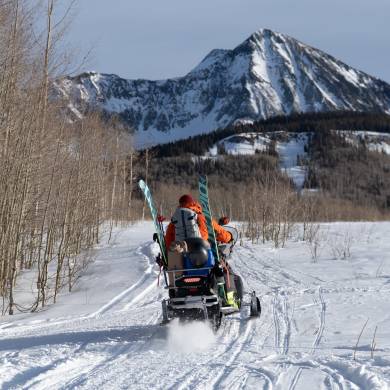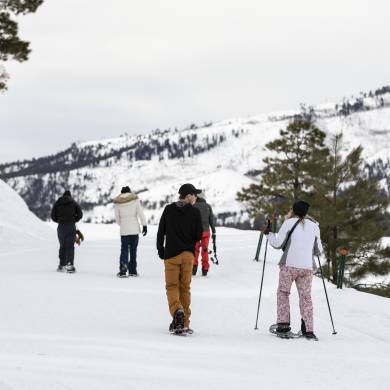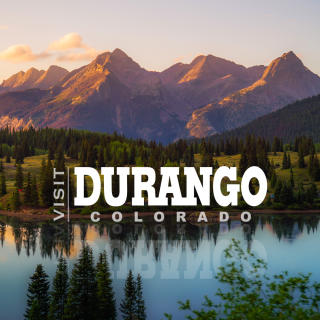A brief introduction to avalanche awareness and how to stay safe in Durango this Winter.
If you’re considering stepping into the backcountry this season, give this a read. The San Juan & La Plata Mountains are some of the most avalanche-prone areas in the lower 48.
Being prepared and knowledgeable is the best way to have a fun and memorable experience while staying safe and out of harm’s way.
We highly suggest taking an avalanche safety course or hiring a licensed guide when heading into the backcountry around Durango or southwest Colorado.
While the topic of avalanche safety and awareness is a complicated and involved one, here is a very brief introduction to being safe in Durango’s backcountry this Winter season.
Proper Gear and Equipment for Avalanche Terrain
Carrying the proper equipment is key to having a safer and more enjoyable day in the backcountry, but remember that having the right gear doesn’t guarantee your safety - knowing how to use it and making safe decisions will.
Gear Essentials to Bring into the Backcountry
If you’ve ever surfed a ski store, online, or in Durango, there are lots of gear and products aimed at preventing disaster and keeping you safe in the backcountry.
These three pieces of gear are essential to finding a buried partner and being found in the event of a burial.
Do not head into the backcountry without these items:
Avalanche transceiver (Beacon)
A similar premise to walkie-talkies, an avalanche transceiver, or “Beacon” as they’re commonly called, is worn on your body and produces a radio signal that is picked up by other nearby avalanche transceivers.
If you become buried in an avalanche, your partner can find you via the radio signal that it produces. Said another way, your partner can “pinpoint” the exact location of where you’ve been buried and then start digging you out.
The range of avalanche transceivers is limited to less than 80 meters (depending on the brand) so your partner will need to be closeby to where they think you’ve been buried in order for your signal to be picked up.
All avalanche transceivers work on the same international frequency (457 kHz) and are compatible between brands and models.
Avalanche shovel
An avalanche shovel has a fairly obvious purpose: digging you out if you’re buried in an avalanche. Most avalanche shovels are collapsable and lightweight so they can be packed in a backpack.
Besides digging someone out, avalanche shovels are also used during snow stability tests prior to determining the overall avalanche conditions of the area you’re exploring.
Probes
Probes are collapsible, metal rods that are connected together and used in rescuing a buried person after an avalanche. At first glance, they resemble heavy-duty tent poles.
When assembled, probes are used to “poke around” into the ground following an avalanche. After the avalanche transceiver locates the buried victim’s general area, probes aid in further narrowing the search area.
In addition, probes also measure the burial depth of the victim so you know how deep to dig to free them from the avalanche debris.
Don’t leave home without this gear!
Always carry these three things on your body and keep your transceiver on at all times.
These three pieces of gear require proper training to minimize any errors and expedite the rescue time.
Don’t head into the backcountry without getting proper training and practicing using this gear!
Still, Very Essential Gear to Bring into the Backcountry
Some pieces of gear are more important than others. The aforementioned avalanche transceiver, shovel, and probe should be carried on you at all times.
The following pieces of gear are also great to have and can help minimize your risk and keep you alive if disaster strikes:
Avalanche airbag or avalung
Consider riding with an avalanche airbag or an avalung. An airbag will increase the chance of you staying on top of a slide. An avalung can provide a longer supply of air during a burial and give rescuers extra time to dig you out. These bags and systems tend to be expensive but are a worthwhile investment.
Winter survival supplies
Bring the proper supplies to survive a Winter night if needed or a long evacuation. Warm layers, a sleep/shelter system, and some way to melt snow or attain water will make all the difference if plans go south and you have to spend the night in the backcountry. A way to make fire can be as simple as a lighter or even a portable camping stove and pot.
Repair kit or replacement parts for your gear
Gear tends to wear and accidents happen. If a piece of gear breaks like a boot or binding, consider bringing repair kits or replacement parts, or even a good roll of duct tape. Wrapping tape around a ski pole is a great way to conserve space and add a useful piece of gear. Binding parts can be salvaged from old, unusable bindings or replacement parts can be ordered online. The last thing you want is to have to walk 5 miles in deep snow because a binding snapped and can’t be used.
Voile straps are rubber straps with an aluminum buckle that are worth their weight in gold. They are a cheap, durable, and lightweight piece of gear that is very versatile and can be used for something as simple as keeping your skis together on your backpack or a makeshift way to fix a binding.
The Non-Essentials
While not absolutely necessary, these pieces of gear can greatly improve your trip or day and can help you survive in harsh conditions.
-
Small, packable stove - being able to boil water is key for a longer stay and having a warm drink while you’re skiing is pretty nice
-
Rescue sleds can make transporting an injured rider much easier and much faster
-
FRS Radio - A very useful tool for communicating with your own party or other groups in case you need help
Get the Proper Training
Having the proper training is key to keeping yourself and your partner safe and learning how to properly use your equipment. Most areas where backcountry travel and recreation are common, have classes and certification courses offered to the public.
Avalanche Awareness Clinics
Avalanche awareness clinics are often a brief safety course offered at little to no cost and cover a wide array of topics in a brief setting.
This is intended as an introduction to those who are interested in getting into backcountry skiing/riding or as a refresher course for those who are already trained or experienced.
AIARE 1 Course
The AIARE 1 is for ANYONE, regardless of method of travel, who wants to recreate in or near avalanche terrain. Students may have attended some awareness classes or an avalanche rescue course, but none are a prerequisite for this course.
Students can expect to develop a good grounding in how to prepare for and carry out a trip in the backcountry, to understand basic decision making, and to learn rescue techniques to find and dig up a buried person.
First Aid & CPR Classes
While not completely necessary, having proper first aid training and skills can help save a life in the event of an accident while waiting for medical professionals.
These courses cost very little and usually only take a few hours.
Things to “Know Before You Go”
The term “know before you go,” or KBYG really includes all aspects of avalanche preparedness, but also includes weather and avalanche forecasts, as well as trip/route planning.
Weather
Looking at the weather forecast prior to your trip in the backcountry is extremely important as it gives you key information on how to layer properly, where you can travel, and if it’s even safe to travel.
Avalanche Conditions
Checking the daily avalanche report will determine where you can ride on that day and if it is even safe to ride. You can find the proper area and report on the CAIC website here. This is also a great place to check out detailed weather reports for the specific area you’re traveling in.
You can also use sites like CalTopo, Gaia, and FatMaps to look at avalanche reports in your area, slope angle shaders, and slope aspects.
Make a Plan
When riding in the backcountry, it's always a best practice to plan out your trip and route ahead of time, and no we don't mean look on google maps in the car on the way out to the mountains.
Having 3 different tour/route options is always a good idea in case your first choice doesn't pan out or isn't very safe. Depending on your goals for the day and the current weather and avalanche conditions, you might want to have a route for a summit option, a route in a familiar area, and a route that might include low angle tree laps.
Some great tools for planning routes in the backcountry include CalTopo and Gaia, both free mapping sites that allow you to look at slope angle shaders, elevation gain and distances for your routes.
Riding with a Guide
Riding with a guide or a group of experienced riders is a great way to get out in the backcountry without committing to tons of gear or expensive certifications. It offers an opportunity to learn and find out if it's an activity you want to pursue. Durango has a handful of options when it comes to guiding services and backcountry experiences.
Purgatory Snowcat Adventures
One of the largest playgrounds for backcountry snowcat skiing in Colorado, Purgatory Snowcats offers fresh tracks and untouched terrain without the work. With 35,000 acres of terrain to explore and heated snowcat cabins, you will have an unforgettable adventure in the San Juans without a doubt.
San Juan Expeditions
San Juan Expeditions is the premier guide service of Durango and its surrounding areas, led by Josh Kling, they offer guided adventures, avalanche courses, and clinics of all kinds.
Conclusion
The San Juans and surrounding mountains are vast and beautiful but deserve an equal amount of respect. Respect the mountains and they will return the favor. We want you to have a blast out in the backcountry, but first and foremost we want to see you be safe, and seek out the proper training and using proper safety measures.






